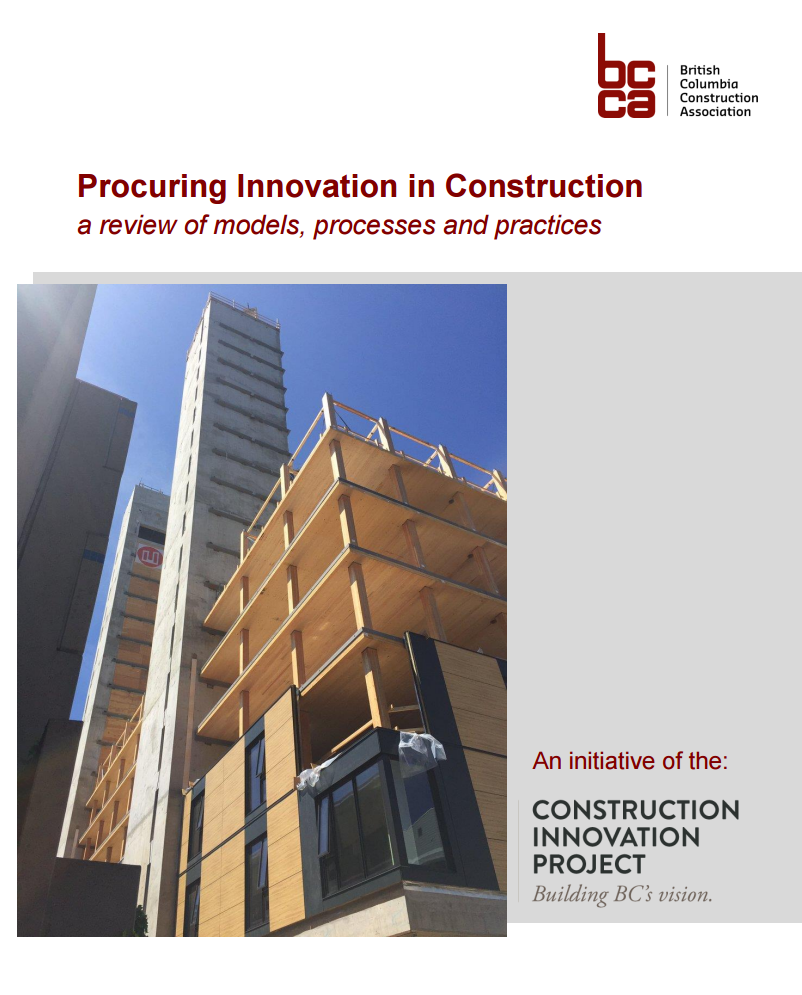Procuring Innovation – Leading practices from British Columbia
Published by the British Columbia Construction Association, this 80 page report is intended to help public and private owners become “innovation friendly” in their construction procurement – to enable them to access the potential environmental, economic and social benefits that innovative construction solutions can bring. It is also intended to guide architecture, engineering and construction firms as they set up their competitive response processes so they can bring their best to projects that push technical and logistical boundaries. Using examples of innovation in mass timber design and construction as a means to illustrate broader themes that can be applied to a wide range of building products and materials, this report explores how innovative solutions can best be encouraged within the many different stages and elements of construction procurement. Best practice models for Tenders and for Requests for Proposal (RFPs) are reviewed along with the various delivery models for their ability to encourage (or hinder) innovation. These include: Design-Bid-Build, Construction Management, Design-Build, Public Private Partnerships (P3s) and Single Purpose Entity for Integrated Project Delivery.
Procurement is an integral part of any construction project. It includes sourcing, purchasing, and all activities related to providing knowledge, manpower, construction equipment, materials, supplies, supervision, and management services necessary to accomplish the project objectives. The range of new ideas, products and processes that can be brought into construction projects is practically limitless so a focus on emerging wood technologies offers a manageable way to explore the complex process of procurement.
The role of owners and clients is central to the success of any project and their role in establishing clear requirements and performance targets is discussed. This includes the need to consider the full life-cycle cost of the project, not just the initial capital cost, sustainability goals and how to define “Quality” in the context of a fair, open and transparent procurement process. An innovative project will invariably bring a different risk profile, which needs to be understood and managed proactively. Assembling and nurturing an integrated, collaborative team is key to success and emerging techniques such as early market engagement, sanctioned design competitions, competitive dialogue and performance incentives are introduced. Numerous tools to facilitate innovative solutions are emerging such as virtual design and construction, offsite construction and project feedback loops that bring research problems from the field back to the lab in an organized manner. The report concludes with a checklist of best practices for both public and private owners.
This report was prepared for the BC Construction Association by Brantwood Consulting.
Lead author: Helen Goodland RIBA MBA
Contributors:
Jim Taggart FRAIC
Kevin Hanvey MAIBC AAA MRAIC, Omicron
Tyler Galbraith, Jenkins Marzban Logan, LLP
The original article was posted here
--Future of Construction 16:21, 15 Jun 2017 (BST)
Featured articles and news
International Electrician Day, 10 June 2025
Celebrating the role of electrical engineers from André-Marie Amperè, today and for the future.
New guide for clients launched at Houses of Parliament
'There has never been a more important time for clients to step up and ...ask the right questions'
The impact of recycled slate tiles
Innovation across the decades.
EPC changes for existing buildings
Changes and their context as the new RdSAP methodology comes into use from 15 June.
Skills England publishes Sector skills needs assessments
Priority areas relating to the built environment highlighted and described in brief.
BSRIA HVAC Market Watch - May 2025 Edition
Heat Pump Market Outlook: Policy, Performance & Refrigerant Trends for 2025–2028.
Committing to EDI in construction with CIOB
Built Environment professional bodies deepen commitment to EDI with two new signatories: CIAT and CICES.
Government Grenfell progress report at a glance
Line by line recomendation overview, with links to more details.
An engaging and lively review of his professional life.
Sustainable heating for listed buildings
A problem that needs to be approached intelligently.
50th Golden anniversary ECA Edmundson apprentice award
Deadline for entries has been extended to Friday 27 June, so don't miss out!
CIAT at the London Festival of Architecture
Designing for Everyone: Breaking Barriers in Inclusive Architecture.
Mixed reactions to apprenticeship and skills reform 2025
A 'welcome shift' for some and a 'backwards step' for others.
Licensing construction in the UK
As the latest report and proposal to licence builders reaches Parliament.
Building Safety Alliance golden thread guidance
Extensive excel checklist of information with guidance document freely accessible.
Fair Payment Code and other payment initiatives
For fair and late payments, need to work together to add value.
Pre-planning delivery programmes and delay penalties
Proposed for housebuilders in government reform: Speeding Up Build Out.
High street health: converting a building for healthcare uses
The benefits of health centres acting as new anchor sites in the high street.


























